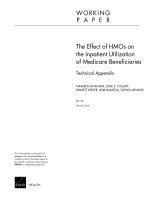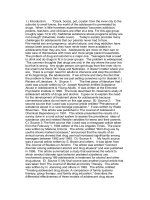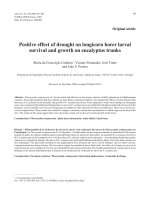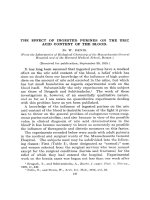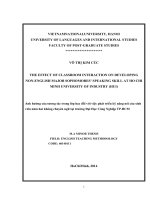Effect of drying methods on physico-chemical characteristics of dehydrated apricots in cold Arid Region of Ladakh
Bạn đang xem bản rút gọn của tài liệu. Xem và tải ngay bản đầy đủ của tài liệu tại đây (200.82 KB, 5 trang )
Int.J.Curr.Microbiol.App.Sci (2019) 8(5): 500-504
International Journal of Current Microbiology and Applied Sciences
ISSN: 2319-7706 Volume 8 Number 05 (2019)
Journal homepage:
Original Research Article
/>
Effect of Drying Methods on Physico-chemical Characteristics of
Dehydrated Apricots in Cold Arid Region of Ladakh
Towseef A. Wani1*, Quraazah A. Amin2, S. Fauzia2, N. Dorjey1, B.A. Zargar1,
Phuntsog Tundup1, Kunzanglamo1, N. Deldan1, R. Safal1 and M.A. Beigh2
1
2
Krishi Vigyan Kendra Leh, SKUAST-K, J&K, India
Division of Food Science and Technology, SKUAST-K, J&K, India
*Corresponding author
ABSTRACT
Keywords
Drying, Apricot,
Leh, Solar,
Moisture
Article Info
Accepted:
07 April 2019
Available Online:
10 May 2019
The present study was carried out to investigate the effect of different drying methods on
physicochemical composition of dehydrated apricot fruits. The fresh apricots were
dehydrated in open sun and in local solar drier developed by Krishi Vigyan Kendra Leh.
The chemical composition showed that the fresh apricots contained moisture 81.7%, ash
0.69%, crude Protein 0.9%, crude fat 0.05%and crude fiber 1.07%. The solar drier and
using open sun drying substantially decreased moisture content to 12.61% and 14.7%
respectively. Proportions of other components were increased, which include ash (3.34%
and 3.13%), crude fat (1.82% and 1.59%), crude protein (0.98% and 0.92%) and Crude
fiber (2.75% and 2.08%) respectively.
most important process in the successful
storage of apricots (Goğuş et al., 2007). The
objective in drying apricots is to reduce the
moisture content to a level that allows safe
storage over an extended period.
Introduction
Apricot (Prunus armeniaca L.) is the most
important fruit crop of Ladakh. Its production
is mostly confined to the lower belt (double
cropped area) of Ladakh, where the climate is
milder. The lower belt includes areas from
Saspol to Batalik, Nubra valley and larger
parts of Kargil. The crop is intimately
associated with the culture and traditions of
the region because it is one of the major
sources of livelihood. Almost every part of
the fruit is used by the local inhabitants; ripe
apricot is an excellent dessert fruit and is used
fortable purposes. Drying is one of the oldest
preservation techniques for foods and is the
The most common drying method for apricots
is open-air sun-drying, requiring low capital,
simple equipment, and low energy input (El
Halouat and Labuza, 1987; Gezer et al.,
2003). Generally, the fruits are spread on
rooftops or on rocks without subjecting them
to any pretreatment or washing with water
(Mir et al., 2009). To decrease the effect of
spoilage reactions, to facilitate the drying
process, to prevent browning, to ensure colour
500
Int.J.Curr.Microbiol.App.Sci (2019) 8(5): 500-504
stability, and to improve the overall product
quality, some pretreatments are advised. One
of these treatments is sulphuring (Rossello et
al., 1993; Lewicki, 2006; Miranda et al.,
2009). Sulphur dioxide is used widely in the
food industry to prevent quality losses of
foods and to reduce fruit darkening rate
during drying and storage. Both enzymatic
and non-enzymatic browning and microbial
activity are prevented by using sulphites at
low concentration (Joslyn and Braverman,
1954).
conserve food by reducing its moisture
content is convective drying (Mundada et al.,
2010). Nevertheless the drying of fruit over a
long time at high temperatures is the biggest
disadvantage of conventional hot-air drying.
The exposure of apricots to high temperatures
for a long time in the presence of oxygen
induces enzymatic and non-enzymatic
oxidation. These conditions lead to some
changes in not only the sensorial attributes of
the product, such as color and flavor, but also
the content and profile of carotenoids (Zhang
et al., 2006; Rodriguez-Amaya, 2010).
The oxygen-scavenging action of sulphur
dioxide helps in stabilizing the carotenes.
When sulphur dioxide is absorbed into the
fruit, it is converted mainly to the bisulphate
ion, which remains free and retards the
formation of Maillard-type compounds, and it
can also be reversibly bound to certain
compounds, such as the carbonyl group of
aldehydes. This bound sulphite is considered
to have no retarding effect on product
deterioration (Bolin and Jackson, 1985; Mir et
al., 2009). It was reported that sulphites cause
some health problems such as asthmatic
reactions when inhaled or ingested by
sensitive individuals (Freedman, 1980;
Miranda et al., 2009). Apricots are rich in
carbohydrates and minerals, having a striking
color and characteristic flavor (Ghorpade et
al., 1995). Sugars such as glucose, fructose,
sucrose, and sorbitol and malic and citric acid
are the main components.
Materials and Methods
Proper healthy and mature Apricot fruits were
selected for this study. The fruits were washed
with deionized water and dipped in already
prepared 1500 ppm potassium metabisulphite
solution for 20 minutes. The fruits were then
kept in pre-washed perforated trays. The trays
were put in locally made solar drier and in
open sun on the roof of KVK Leh. The solar
drier (Fig. 1) moved according the direction
of sun 9:00 am and 4:00 pm. The solar drier
temperature reached to 55-65 °C maximum
and the open sun maximum temperature was
noted up to 22-28 °C during the month of
August. The apricot dehydrated in solar drier
during 48 hours (approximate 2 days) while
apricot dehydrated in open sun during 168
hours (7days). The trays collected from solar
drier and open sun were packed in
polyethylene zip lock bags for further
physicochemical evaluation.
The most abundant minerals are potassium
and iron. The apricot fruit is an important
source of provitamin A carotenoids, as 250 g
of fresh or 30 g of dried fruit supplies 100%
of the RDA (recommended dietary allowance)
of carotenoids. Additionally, chlorogenic and
neochlorogenic acids, (+)-catechin, (-)epicatechin and rutin (or quercetin-3rutinoside) are the most important phenolic
compounds in this fruit (Drogoudi et al.,
2008). However, the most preferred way to
Physicochemical analysis
Moisture, total ash, crude fat, crude protein,
crude fiber and carbohydrates were
determined according to the Association of
Analytical Communities (AOAC) methods.
Crude protein was estimated by kjeldhal
method, Carbohydrates were determined by
difference method indicated below.
501
Int.J.Curr.Microbiol.App.Sci (2019) 8(5): 500-504
open sun dehydrated samples (0.92%). The
lowest value of protein (%) of apricot (0.9%)
was recorded in fresh apricot samples and the
results were highly significant. The highest
(%) of fat observed in solar drier dehydrated
samples i.e. (1.82%) followed by open sun
dehydrated samples (1.59%). The lowest
value of fat (%) of apricot (0.05%) was
recorded in fresh apricot samples and the
results were highly significant. The highest
(%) of crude fiber was observed in solar drier
dehydrated samples i.e. (2.75%) followed by
open sun dehydrated samples (2.08%).
Results and Discussion
Physicochemical
dehydrated apricot
composition
of
The highest moisture content was recorded in
fresh apricot i.e. (81.7%), followed by the
open sun drying apricot was found to be
(14.7%) whereas, the lowest values (12.61%)
was recorded in the solar dehydrated apricot
sample and the results are highly significant
(p<0.01) among the different methods. The
highest ash (3.34%) was found in solar
dehydrated sample fallowed by open sun
drying sample at (3.13%), whereas the lowest
(0.69%) ash observed in the fresh apricot
sample, which were significantly different
from each other. Simultaneously, high
moisture content tends to promote
microbiological contamination and chemical
degradation. The results obtain from
dehydrated sample was statistically different
as compared to fresh samples. The highest
(%) of protein was observed in solar drier
dehydrated samples i.e. (0.98%) followed by
This study showed that apricot has high
moisture (81.7%). It is known that products
that have low fat values normally have high
moisture contents. Moisture (%) is a widely
used parameter in the processing and testing
of food. The observed value implies that
cauliflower may have a short shelf-life since
microorganisms that cause spoilage thrive in
foods having high moisture content and also
is indicative of low total solids (Table 1 and
2).
Table.1 Proximate composition of fresh apricot
S.no
1
2
4
5
6
Parameter
Moisture
Ash
Protein
Fat
Fibre
Result
81.7
0.69
0.90
0.05
1.07
Table.2 Open sun and solar drying of apricots
S.no
1
2
4
5
6
Parameter
Moisture
Ash
Crude Protein
Crude Fat
Crude Fiber
Results
Open Sun dehydrated
solar drier dehydrated apricot
apricot (%)
(%)
14.7
12.61
3.13
3.34
0. 92
0.98
1.59
1.82
2.08
2.75
502
Int.J.Curr.Microbiol.App.Sci (2019) 8(5): 500-504
Fig.1 Solar drier developed in KVK Leh
The high moisture content of apricot is
consistent with the report (Samann., 1991) of
which a high moisture value for fruits like
white mulberry (82.50%) and black mulberry
(78.03%) was observed. Protein (%) in
apricot is (0.9%) is low and similar to these
values reported by researchers in other fruits.
such as “mulberry” (1.73%). The fat of
apricots (0.03%) is lower than that of kale
(0.26%) (Ali et al., 2011). Since fresh and dry
apricot fruit has low fat (%), it can be used by
individuals as a low caloric diet to reduce
weight. The fiber (%) of apricot (1.07%) was
found to be lower than some other fruits such
as “mulberry” 1.1%. Fiber cleanses the
digestive tract, by removing potential
carcinogens from the body and prevents the
absorption of excess cholesterol. Fiber also
adds bulk to the food and prevents the intake
of excess starchy food and may therefore
guard against metabolic conditions such as
hypercholesterolemia and diabetes mellitus.
Fiber can also help to keep blood sugar levels
under control (Akin et al., 2008; Aubert and
Chaforan, 2007). Solar dehydrated and open
sun dehydrated apricot samples had higher
proximate analysis values due to removal of
moisture.
The findings of this study show that the solar
dehydration and open sun drying of apricot
fruit are effective in preserving the chemical
composition of apricot and preventing
deterioration by reducing moisture.. The fruits
dehydrated
using solar dryer were
hygienically more acceptable as compared to
open sun dehydration.
References
Abdelhaq, E.H., & Labuza, T. P. (1987). Air
drying characteristics of apricots. Journal of
Food Science, 52(2), 342-345
Akin, EB., Karabulut I, Topcu A. Some
compositional properties of main Malatya
apricot (Prunus armeniaca) varieties. Food
Chem. 2008; 107(2): 939-948.
Ali, S., Masud T, Abbasi KS. Physico-chemical
characteristics
of
apricot
(Prunus
armeniaca L.) grown in Northern Areas of
Pakistan. Sci Hort. 2011; 130(2): 386-392.
Aubert, C., Chaforan C. Postharvest changes in
physicochemical properties and volatile
constituents of apricot (Prunus armeniaca
L.). Characterization of 28 cultivars. J
Agric Food Chem. 2007: 55: 3074-3082.
Bolin, HR., Jackson R (1985). Factors affecting
503
Int.J.Curr.Microbiol.App.Sci (2019) 8(5): 500-504
sulphur dioxide binding in dried apples and
apricots. J Food Process Pres 9: 25-34.
Drogoudi, P.D., Vemmos, S., Pantelidis, G.,
Petri, E., Tzoutzoukou, C., and Karayiannis,
I. (2008). Physical characters and
antioxidant, sugar, and mineral nutrient
contents in fruit from 29 apricot (Prunus
armeniaca L.) cultivars and hybrids.
Journal of Agricultural and Food
Chemistry, 56(22), 10754-10760
El Halouat A, Labuza, TP (1987). Air drying
characteristics of Apricots. J Food Sci 52:
342-345.
Freedman, BJ. (1980). Sulphur dioxide in foods
and beverages: its use as a preservative and
its effect on asthma. Br J Dis 74: 128-134.
Gezer I, Acaroğlu M, Haciseferoğullari H
(2003). Use of energy and labour in apricot
agriculture in Turkey. Biomass Bioenerg
24: 215-219
Goğuş, F., Ozel MZ, Lewis AC (2007).The
effect of various drying techniques on
apricot volatiles using direct thermal
desorption- GC-TOF/MS. Talanta 73: 321325
Joslyn, MA., Braverman JB (1954). The
chemistry and technology of the
pretreatment and preservation of fruit and
vegetable products with sulphur dioxide
and sulphites. Adv Food Res 5:97-160.
Karatas, F., and Kamıslı, F. (2007). Variations
of vitamins (A, C and E) and MDA in
apricots dried in IR and microwave.
Journal of Food Engineering, 78(2), 662668. Journal of food engineering.
2005.10.040.
Lewicki, P.P., (2006). Design of hot air drying
for better foods. Trends Food Sci Tech 17:
153-163
Mir, MA., Hussain, PR, Fouzia S, Rather AH
(2009). Effect of sulphuring and drying
methods on physico-chemical and sensorial
quality of dried apricots during ambient
storage. Int J Food Sci Tech 44: 1157-1166.
Miranda, G., Berna A, Salazar D, Mulet A
(2009). Sulphur dioxide evolution during
dried apricot storage. LWT-Food Sci Tech
42: 531-533.
Mundada, M., Hathan, B. S., and Maske, S.
(2010).Convective dehydration kinetics of
osmotically pretreated pomegranate arils
pretreated pomegranate arils. Biosystems
Engineering, 107(4), 307-316.
Rodriguez-Amaya, D.B., (2010). Quantitative
analysis,
in
vitro
assessment
of
bioavailability and antioxidant activity of
food carotenoids: a review. Journal of Food
Composition and Analysis, 23(7), 726-740
Rossello, C., Canellas J, Santiesteban I, Mulet
A (1993). Simulation of the absorption
process of sulphur dioxide in apricots. LWT
Food Sci Tech 26: 322-328.
Sablanı, S.S., (2006). Drying of fruits and
vegetable:
retention
of
nutritional/
functional quality. Drying Technology,
24(2), 123-135.
Samann, H., Suitability of indigenous fruit.
Cultivars for the production of dried fruit.
Mitteilungen-Klosterneubury Rebe Und
Wein, Obstbau and Fruchtever Wertung.
1991; 41(3): 127-133.
Zhang, M., Tang, J., Mujumdar, A., and Wang,
S. (2006). Trends in microwave related
drying of fruits and vegetables. Trends in
Food Science & Technology, 17(10), 524534.
How to cite this article:
Towseef A. Wani, Quraazah A. Amin, S. Fauzia, N. Dorjey, B.A. Zargar, Phuntsog Tundup,
Kunzanglamo, N. Deldan, R. Safal and Beigh, M.A. 2019. Effect of Drying Methods on
Physico-chemical Characteristics of Dehydrated Apricots in Cold Arid Region of Ladakh.
Int.J.Curr.Microbiol.App.Sci. 8(05): 500-504. doi: />
504
